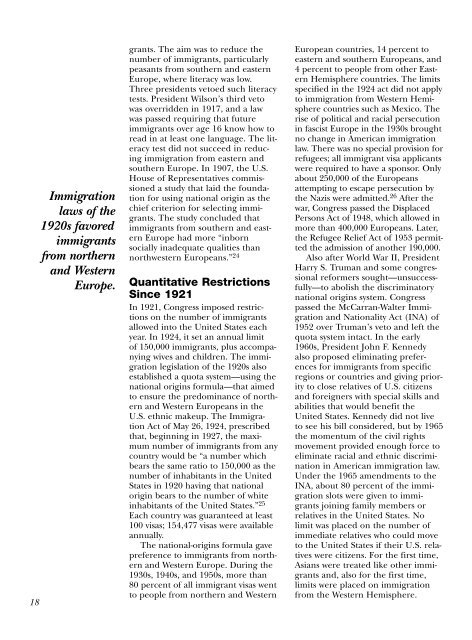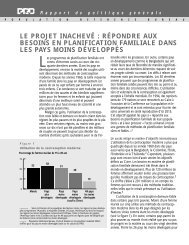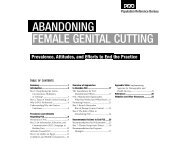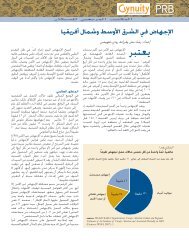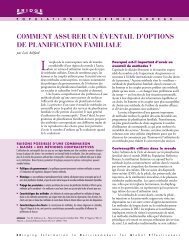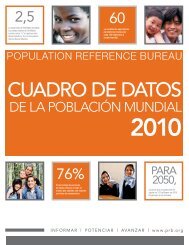Immigration Shaping America - Population Reference Bureau
Immigration Shaping America - Population Reference Bureau
Immigration Shaping America - Population Reference Bureau
You also want an ePaper? Increase the reach of your titles
YUMPU automatically turns print PDFs into web optimized ePapers that Google loves.
18<br />
<strong>Immigration</strong><br />
laws of the<br />
1920s favored<br />
immigrants<br />
from northern<br />
and Western<br />
Europe.<br />
grants. The aim was to reduce the<br />
number of immigrants, particularly<br />
peasants from southern and eastern<br />
Europe, where literacy was low.<br />
Three presidents vetoed such literacy<br />
tests. President Wilson’s third veto<br />
was overridden in 1917, and a law<br />
was passed requiring that future<br />
immigrants over age 16 know how to<br />
read in at least one language. The literacy<br />
test did not succeed in reducing<br />
immigration from eastern and<br />
southern Europe. In 1907, the U.S.<br />
House of Representatives commissioned<br />
a study that laid the foundation<br />
for using national origin as the<br />
chief criterion for selecting immigrants.<br />
The study concluded that<br />
immigrants from southern and eastern<br />
Europe had more “inborn<br />
socially inadequate qualities than<br />
northwestern Europeans.” 24<br />
Quantitative Restrictions<br />
Since 1921<br />
In 1921, Congress imposed restrictions<br />
on the number of immigrants<br />
allowed into the United States each<br />
year. In 1924, it set an annual limit<br />
of 150,000 immigrants, plus accompanying<br />
wives and children. The immigration<br />
legislation of the 1920s also<br />
established a quota system—using the<br />
national origins formula—that aimed<br />
to ensure the predominance of northern<br />
and Western Europeans in the<br />
U.S. ethnic makeup. The <strong>Immigration</strong><br />
Act of May 26, 1924, prescribed<br />
that, beginning in 1927, the maximum<br />
number of immigrants from any<br />
country would be “a number which<br />
bears the same ratio to 150,000 as the<br />
number of inhabitants in the United<br />
States in 1920 having that national<br />
origin bears to the number of white<br />
inhabitants of the United States.” 25<br />
Each country was guaranteed at least<br />
100 visas; 154,477 visas were available<br />
annually.<br />
The national-origins formula gave<br />
preference to immigrants from northern<br />
and Western Europe. During the<br />
1930s, 1940s, and 1950s, more than<br />
80 percent of all immigrant visas went<br />
to people from northern and Western<br />
European countries, 14 percent to<br />
eastern and southern Europeans, and<br />
4 percent to people from other Eastern<br />
Hemisphere countries. The limits<br />
specified in the 1924 act did not apply<br />
to immigration from Western Hemisphere<br />
countries such as Mexico. The<br />
rise of political and racial persecution<br />
in fascist Europe in the 1930s brought<br />
no change in <strong>America</strong>n immigration<br />
law. There was no special provision for<br />
refugees; all immigrant visa applicants<br />
were required to have a sponsor. Only<br />
about 250,000 of the Europeans<br />
attempting to escape persecution by<br />
the Nazis were admitted. 26 After the<br />
war, Congress passed the Displaced<br />
Persons Act of 1948, which allowed in<br />
more than 400,000 Europeans. Later,<br />
the Refugee Relief Act of 1953 permitted<br />
the admission of another 190,000.<br />
Also after World War II, President<br />
Harry S. Truman and some congressional<br />
reformers sought—unsuccessfully—to<br />
abolish the discriminatory<br />
national origins system. Congress<br />
passed the McCarran-Walter <strong>Immigration</strong><br />
and Nationality Act (INA) of<br />
1952 over Truman’s veto and left the<br />
quota system intact. In the early<br />
1960s, President John F. Kennedy<br />
also proposed eliminating preferences<br />
for immigrants from specific<br />
regions or countries and giving priority<br />
to close relatives of U.S. citizens<br />
and foreigners with special skills and<br />
abilities that would benefit the<br />
United States. Kennedy did not live<br />
to see his bill considered, but by 1965<br />
the momentum of the civil rights<br />
movement provided enough force to<br />
eliminate racial and ethnic discrimination<br />
in <strong>America</strong>n immigration law.<br />
Under the 1965 amendments to the<br />
INA, about 80 percent of the immigration<br />
slots were given to immigrants<br />
joining family members or<br />
relatives in the United States. No<br />
limit was placed on the number of<br />
immediate relatives who could move<br />
to the United States if their U.S. relatives<br />
were citizens. For the first time,<br />
Asians were treated like other immigrants<br />
and, also for the first time,<br />
limits were placed on immigration<br />
from the Western Hemisphere.


